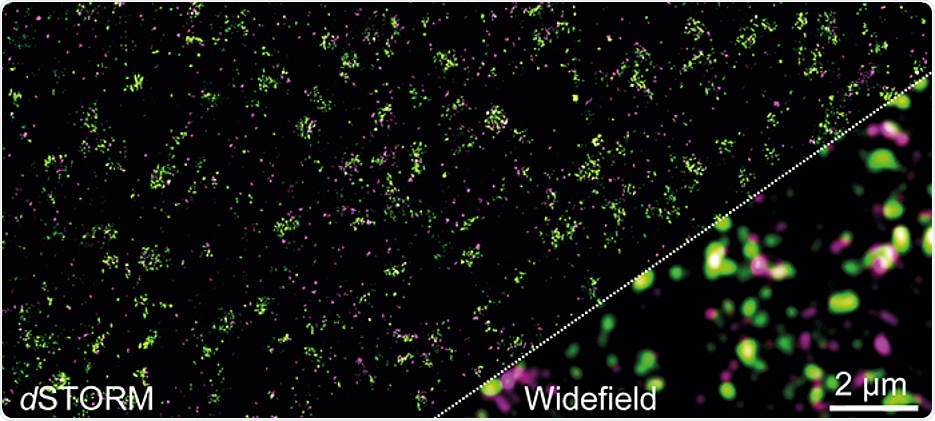The glutamate receptors do not actually adhere to “distance keeping.” Now, high-resolution microscopic studies have revealed that the receptors often appear in small groups at the synapses and remain in contact with other proteins.

The distribution of the glutamate receptor mGluR4 and other proteins in the presynaptic membrane. Left: a high-resolution dSTORM image. Right: the result obtained with conventional fluorescence microscopy—molecular details are not visible here. Image Credit: Lehrstuhl Markus Sauer/Universität Würzburg.
Glutamate is often remembered as a flavor enhancer that is used in Asian cuisine. Glutamate also plays an essential role in the human nervous system, as an important messenger substance, contributing to memory and learning processes.
For example, a few Alzheimer drugs retard the development of the disease by preventing the glutamate effect.
Glutamate functions as a signal transmitter at the synapses in the nervous system, binding to several types of specific receptors. A significant role is played by the metabotropic glutamate receptor of type 4 (mGluR4) in this system.
Direct contact with other proteins
The distribution of this particular receptor in the active zones of synapses was barely known until now. It has now become obvious that most of the mGluR4 receptors are present in groups of one to two units on average in the presynaptic membrane.
They are often found to be in direct contact with the protein Munc-18-1 and calcium channels, which is crucial for the release of messengers.
A research team guided by Professor Markus Sauer from the Biocenter of Julius-Maximilians-Universität (JMU) Würzburg in Bavaria, Germany, and also by Professor Davide Calebiro from the University of Birmingham in England, has disclosed this finding in the Science Advances journal.
Our data indicate that the direct contact of mGluR4 receptors with other key proteins plays a major role in the regulation of synapse activity.”
Markus Sauer, Professor, Biocenter of Julius-Maximilians-Universität Würzburg
Active zones are densely packed
dSTORM—short for direct stochastic optical reconstruction microscopy—is a super-resolution microscopy method that offered this new insight. Sauer’s team developed this method in 2008.
Through this method, individual molecules can be positioned even in the densely packed and very small active zones of synapses. But this is not possible with traditional light microscopy as it has a diffraction limit of 200 nm.
For the first time we now have insights into the molecular organization of the complex protein machines that control the signal transmission at the synapses of our brain.”
Davide Calebiro, Professor, University of Birmingham
The functioning of the brain and the processing of information on different time scales can be understood only with this perception.
Going forward, the distribution of all the proteins in the active synaptic zone will be explored by the research teams using the dSTORM method. The general assumption is that over 100 proteins play a role in signal transmission in the active zones.
Source:
Journal reference:
Siddig, S., et al. (2020) Super-resolution imaging reveals the nanoscale organization of metabotropic glutamate receptors at presynaptic active zones. Science Advances. doi.org/10.1126/sciadv.aay7193.